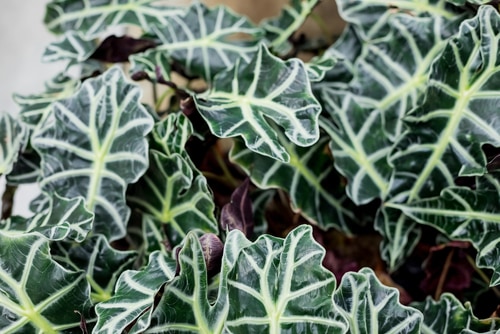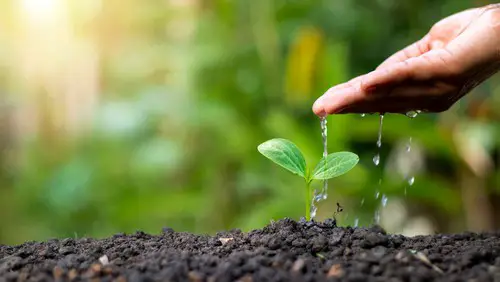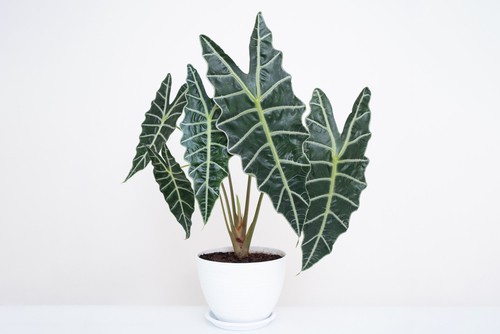Alocasia Polly is a popular houseplant known for its striking foliage and easy care requirements. However, yellowing leaves can be a common issue that many plant owners face. If you notice your Alocasia Polly turning yellow, it could be an indication of an underlying problem that needs to be addressed.
Understanding Alocasia Polly is the first step in identifying the cause of yellowing leaves. This plant thrives in bright, indirect light and requires consistent moisture to grow.
Common causes of yellowing leaves include overwatering, low humidity, nutrient deficiencies, fungal diseases, pest infestations, and insufficient light. By addressing these issues, plant owners can help their Alocasia Polly thrive and maintain its vibrant green foliage.
Key Takeaways
- Yellowing leaves are a common issue with Alocasia Polly plants.
- Understanding the plant’s care requirements is essential in identifying the cause of yellowing leaves.
- Common causes of yellowing leaves include overwatering, low humidity, nutrient deficiencies, fungal diseases, pest infestations, and insufficient light.
Related posts:
- Pepper Plant Leaves Turning Yellow with Brown Spots
- Pencil Cactus Turning Yellow
- Peacock Plant Leaves Turning Yellow
Understanding Alocasia Polly

Alocasia Polly Plant Overview
The Alocasia Polly, also known as the African Mask Plant, is a popular indoor plant that is native to Southeast Asia. It is a member of the Araceae family and is closely related to other popular house plants such as the Philodendron and the Monstera.
The Alocasia Polly is known for its striking, arrowhead-shaped leaves that are dark green in color and have prominent white veins.
The Alocasia Polly is a relatively small plant, growing to a maximum height of around 2-3 feet. It is a slow-growing plant that can take several years to reach its full height. The plant typically produces new leaves from a central stem, with the older leaves dying off as the plant matures.
Ideal Growth Conditions
To keep your Alocasia Polly healthy and prevent it from turning yellow, it is important to provide it with the right growing conditions. Here are some ideal growth conditions for the Alocasia Polly:
- Light: The Alocasia Polly prefers bright, indirect light. Direct sunlight can scorch the leaves, so it is best to keep the plant in a partially shaded area.
- Temperature: The Alocasia Polly thrives in warm, humid environments. Ideally, the plant should be kept in an area with a temperature between 60-85°F (16-29°C).
- Water: Overwatering is a common cause of yellowing in Alocasia Polly leaves. It is important to allow the soil to dry out slightly between watering. The plant should be watered when the top inch of soil feels dry to the touch.
- Soil: The Alocasia Polly prefers well-draining soil that is rich in organic matter. A soil mix that contains peat moss, perlite, and vermiculite is ideal.
- Humidity: The Alocasia Polly thrives in humid environments. If the air in your home is dry, consider using a humidifier or placing a tray of water near the plant to increase humidity.
- Fertilizer: The Alocasia Polly benefits from regular fertilization during the growing season (spring and summer). Use a balanced fertilizer every 2-3 weeks to provide the plant with essential nutrients.
By providing your Alocasia Polly with the right growing conditions, you can help prevent yellowing and keep your plant healthy and thriving.
Why Is My Alocasia Polly Turning Yellow – 7 Common Problems
Alocasia Polly is a beautiful plant that can add a touch of tropical elegance to any indoor space. However, yellowing leaves can be a common issue that many plant owners face.
There are several reasons why the leaves of your Alocasia Polly might be turning yellow, including overwatering, underwatering, lighting issues, temperature stress, pest infestation, disease and fungal infections, nutrient deficiency, and natural aging.
1. Overwatering and Underwatering

Overwatering is one of the most common causes of yellowing leaves in Alocasia Polly. When the plant is overwatered, the soil becomes waterlogged, and the roots cannot get enough oxygen. This can lead to root rot, which can cause the leaves to turn yellow and wilt.
Underwatering can also cause yellowing leaves. When the plant is not watered enough, the leaves can become dry and yellow.
To prevent overwatering or underwatering, it is important to water your Alocasia Polly only when the top inch of soil is dry. It is also important to use well-draining soil to prevent water from pooling around the roots.
2. Lighting Issues
Alocasia Polly requires bright, indirect light to thrive. If the plant is not getting enough light, the leaves can turn yellow. Direct sunlight can also cause the leaves to yellow, so it is important to place the plant in a spot where it can get bright, indirect light.
3. Temperature Stress
Alocasia Polly prefers warm temperatures and high humidity. If the plant is exposed to temperatures below 60°F or above 85°F, the leaves can turn yellow. It is important to keep the plant in a warm, humid environment to prevent temperature stress.
4. Pest Infestation
Pests like spider mites and insects can also cause yellowing leaves in Alocasia Polly. These pests feed on the plant’s leaves, causing them to turn yellow and wilt. It is important to regularly inspect your plant for signs of pest infestation and take action to prevent or treat it.
5. Disease and Fungal Infections
Diseases and fungal infections can also cause yellowing leaves in Alocasia Polly. These infections can be caused by overwatering, poor air circulation, or contaminated soil. It is important to treat the infection promptly to prevent it from spreading to other parts of the plant.
6. Nutrient Deficiency
Alocasia Polly requires regular fertilization to maintain its health. If the plant is not getting enough nutrients, the leaves can turn yellow. It is important to fertilize the plant regularly with a balanced fertilizer to prevent nutrient deficiency.
7. Natural Aging
Finally, it is important to remember that yellowing leaves can be a natural part of the aging process for Alocasia Polly. As the plant grows, the older leaves will naturally turn yellow and fall off to make room for new growth.
Watering and Moisture Management
Alocasia Polly plants require careful watering and moisture management to thrive. Overwatering or underwatering can both cause the plant’s leaves to turn yellow. In this section, we will discuss proper watering technique, maintaining soil moisture, and humidity requirements.
1. Proper Watering Technique

Proper watering technique is crucial for Alocasia Polly plants. The plant prefers to be kept damp but not wet or saturated. To water the plant, wait until 25-50% of the soil volume is dry, then water the plant until water drains out of the bottom of the pot. It is important to avoid letting the plant sit in standing water as this can lead to root rot.
2. Maintaining Soil Moisture
Maintaining soil moisture is also important for Alocasia Polly plants. The plant prefers well-draining soil that retains moisture without becoming waterlogged.
It is important to avoid letting the soil dry out completely as this can cause the plant’s leaves to wilt and turn yellow. To maintain soil moisture, consider using a moisture meter to check the soil’s moisture level regularly.
3. Humidity Requirements
Alocasia Polly plants require high humidity to thrive. Low humidity can cause the plant’s leaves to turn yellow and crisp. To maintain proper humidity levels, consider misting the plant’s leaves regularly or using a humidifier. Placing a tray of water near the plant can also help to increase humidity levels.
Lighting and Temperature Control
Ideal Lighting Conditions
Alocasia Polly prefers bright, indirect light. Direct sunlight can scorch the leaves, while low light conditions can cause the leaves to turn yellow. Alocasia Polly can tolerate some direct sunlight during the early morning or late afternoon hours, but it is best to avoid exposing the plant to direct sunlight during the hottest part of the day.
If the plant is not receiving enough light, it may become leggy and the leaves may turn yellow. In this case, it is recommended to move the plant to a brighter location or supplement natural light with artificial light. Grow lights can be used to provide the plant with the necessary amount of light.
Temperature Requirements
Alocasia Polly prefers warm temperatures between 60°F and 80°F (15°C to 27°C). The plant can tolerate temperatures as low as 55°F (13°C), but it is best to avoid exposing the plant to temperatures below this range. Fluctuations in temperature can also cause stress to the plant, resulting in yellowing leaves.
It is recommended to keep the plant away from cold drafts and air conditioning vents, as these can cause the temperature to drop rapidly. Alocasia Polly can benefit from increased humidity, which can be achieved by placing a humidifier nearby or placing a tray of water near the plant.
Soil and Fertilizer Requirements

Choosing the Right Soil
Choosing the right soil is crucial for the health of an Alocasia Polly plant. The plant requires well-draining soil that is rich in nutrients. It is recommended to use a well-draining soil mix that contains perlite to ensure proper drainage.
Perlite is a volcanic glass that is added to soil mixes to improve drainage and aeration. Alocasia Polly plants thrive in well-draining soil because it allows for proper oxygen flow to the roots.
Fertilizer Use
Alocasia Polly plants require regular fertilization to maintain their health and prevent the depletion of soil nutrients. It is recommended to use a balanced fertilizer that contains equal amounts of nitrogen, phosphorus, and potassium.
Alocasia Polly plants require a nitrogen-rich fertilizer to encourage leaf growth. It is important to avoid over-fertilization, as this can lead to salt buildup in the soil, which can be harmful to the plant.
Fertilizer should be applied to the soil every two weeks during the growing season, which is typically from spring to fall. During the winter months, fertilizer should be applied once a month. It is important to follow the manufacturer’s instructions when applying fertilizer to avoid over-fertilization.
Pest and Disease Management
Identifying Common Pests
Alocasia Polly is susceptible to pest infestations, which can lead to yellowing leaves. Mealybugs and scale insects are common pests that can infest Alocasia Polly.
Mealybugs are small, white, fluffy insects that feed on the sap of the plant, causing damage to the leaves. Scale insects, on the other hand, are small, hard-shelled insects that attach themselves to the leaves and stems of the plant, causing damage to the plant tissues.
Disease Prevention and Treatment

Prevention is key to avoiding diseases in Alocasia Polly. Overwatering can lead to root rot, which can cause yellowing leaves. Make sure to water your plant sparingly and only when the soil is dry. Additionally, make sure the soil is well-draining to prevent water from accumulating in the pot.
If you notice yellowing leaves on your Alocasia Polly, it may be a sign of a fungal disease. Fungal diseases can be treated with a fungicide. Make sure to follow the instructions on the fungicide label carefully to avoid damaging the plant.
Thrips are another common pest that can infest Alocasia Polly. These tiny insects can cause damage to the leaves, leading to yellowing and wilting. Insecticidal soap or neem oil can be used to treat thrips infestations. These treatments are effective in controlling the population of thrips and preventing further damage to the plant.
Repotting and Pruning
When and How to Repot
If an Alocasia Polly is turning yellow, it may be a sign that it needs to be repotted. Repotting can help prevent root rot, which is a common cause of yellowing leaves.
When repotting, it is important to choose a pot that is slightly larger than the current one. A pot that is too large can cause the soil to retain too much moisture, which can lead to root rot.
Before repotting, make sure the plant is well-watered. This will help prevent the roots from becoming damaged during the repotting process. Gently remove the plant from its current pot, being careful not to damage the roots. If the roots are tightly packed, gently loosen them.
Add fresh potting soil to the new pot, making sure there is a drainage hole at the bottom. Place the plant in the new pot and fill in the gaps with soil. Water the plant thoroughly and let it drain.
Pruning Yellow Leaves
If an Alocasia Polly has yellow leaves, it may be necessary to prune them. Pruning can help the plant focus its energy on new growth instead of trying to sustain damaged leaves. To prune yellow leaves, use a pair of sharp, clean scissors or pruning shears.
Start by identifying the yellow leaves. These are usually the lower leaves, which are older and less productive. Cut the leaf stem as close to the base of the plant as possible. Be careful not to damage any healthy leaves or stems.
After pruning, monitor the plant for new growth. If new growth does not appear within a few weeks, it may be necessary to adjust the plant’s care routine or consider repotting.
Conclusion

There are several reasons why the leaves of an Alocasia Polly plant may turn yellow. These reasons can include overwatering, underwatering, pests, diseases, low light conditions, and environmental stress.
To prevent yellowing of the leaves, it is important to maintain the right balance of water and light for the Alocasia Polly plant. This can be achieved by watering the plant only when the top inch of soil is dry, and placing it in a spot where it can receive bright, indirect light.
If the Alocasia Polly plant is suffering from pests or diseases, it is important to take immediate action to prevent further damage. This can include using natural remedies such as neem oil or insecticidal soap, or seeking professional help if the infestation is severe.
It is also important to ensure that the Alocasia Polly plant has enough nutrients to support its growth. This can be achieved by fertilizing the plant every two weeks during the growing season with a balanced fertilizer.
Frequently Asked Questions
What causes yellow spots on alocasia leaves?
Yellow spots on alocasia leaves can be caused by various factors such as overwatering, underwatering, low humidity, nutrient deficiency, pest infestation, or fungal diseases. It is important to identify the underlying cause and address it promptly to prevent further damage to the plant.
How do I save my alocasia polly from yellowing?
To save an alocasia polly from yellowing, it is important to identify the underlying cause and address it promptly. Overwatering is a common cause of yellowing, so make sure to adjust the watering schedule and ensure that the soil is well-draining.
Providing adequate humidity, fertilizing regularly, and treating any pest or fungal infestation can also help save the plant.
What is the ideal light condition for alocasia polly?
Alocasia polly thrives in bright, indirect light. However, direct sunlight can scorch its leaves, while low light can cause the leaves to turn yellow and droop.
It is recommended to place the plant near a window that receives bright, indirect light, or use artificial grow lights to supplement the natural light.
Why are my alocasia leaves drooping?
Drooping leaves on alocasia can be a sign of underwatering, overwatering, low humidity, or pest infestation. Adjusting the watering schedule, providing adequate humidity, and treating any pest infestation can help revive the plant and prevent further drooping.
Should I cut yellow leaves off my alocasia polly?
It is recommended to cut off yellow leaves from alocasia polly to prevent the spread of any fungal or bacterial diseases. However, if the yellowing is due to a nutrient deficiency or environmental stress, addressing the underlying cause can help the plant recover without the need for pruning.
Can yellow alocasia leaves turn green again?
If the underlying cause of yellowing is addressed promptly, yellow alocasia leaves can turn green again. However, if the yellowing is due to irreversible damage or disease, the leaves may not recover and may need to be pruned off.

Hey, I’m Lisa and I’ve been an avid gardener for over 30 years. I love writing, talking and living in the garden! Feel free to connect with me on my socials below


